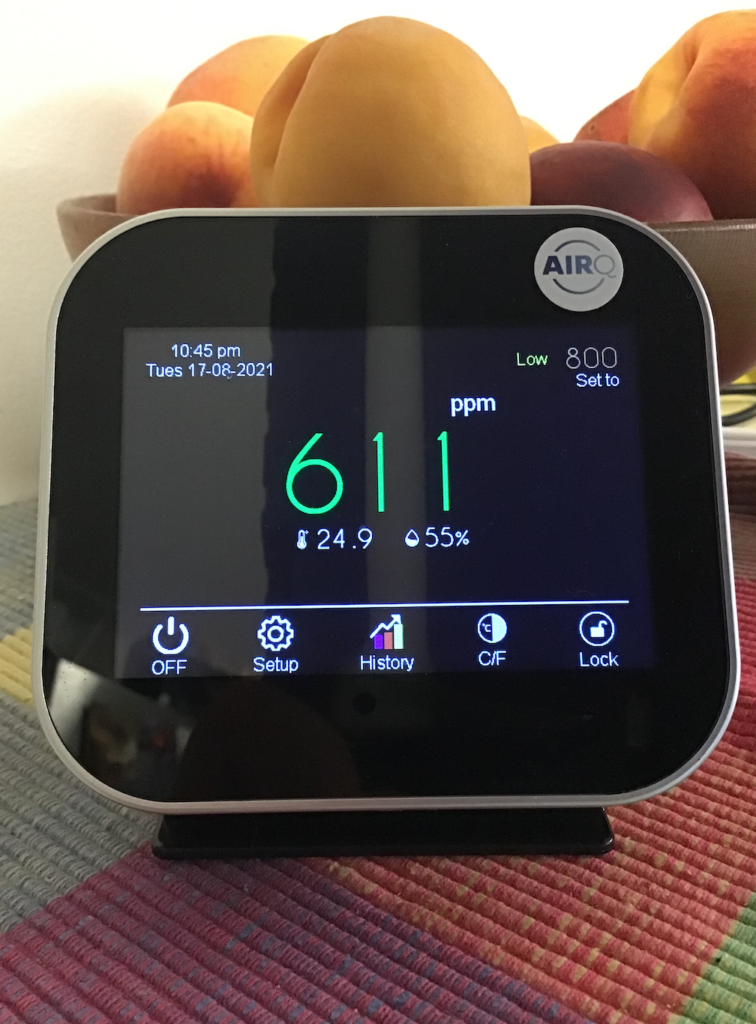
Introduction
COVID has changed everything about campus life. In order to maximize the safety of students, staff and faculty at York University, we, as a community, need to focus on multiple factors, including:
- Vaccinations
- Ventilation (and air filtering)
- Masking
- Progressive work / study policies
Last week, our university partially caved to pressure from the YorkU community (Dawn, Cameron, Markus, John and others... you're fantastic community builders!), the general public and interest groups who have demanded some form of "proof of vaccination." I won't delve into that, other than to see that the vast majority of such announcements at universities and colleges across Ontario are hollow and do not meet the requirements of what was being demanded. It's for this reason that I'm saying that they "partially" caved. This needs verification. It needs follow-up.

Ventilation (and filtering)
Here, I want to focus on the issue of ventilation on campus. First, COVID is primarily transmitted through aerosols -- basically, it hangs in the air for a long time, and if you breathe enough of this virus-laden air, you'll catch COVID. The evidence for this began mounting early in the pandemic, but it was only in late 2020 and early 2021 that the peer-reviewed evidence gained traction.(5) Say it with me, now:
"COVID is airborne"
Dr. Jose-Luis Jiminez, Dr. Marwa Zaatari, Dr. Kimberly Prather, and many, many others

Me? In the summer of 2020 I didn't appreciate the difference between aerosols and droplets. But I knew that wearing a good mask, distancing and staying away from indoor situations would help me and my family stay healthy. Now, I understand that there is a difference between droplets and aerosols and that fact is key to making the very best, most efficient and effective decisions with respect to safe air. Now that we know that scientists recognize that the major transmission mode for COVID is airborne (aerosol), we can apply best principles (6) from ventilation engineers to combat COVID. In short:
The engineers have been speaking up about this for a long time.(5, 6) The Ontario Society of Professional Engineers (OSPE) and individuals like Mr. David Elfstrom, PEng have been vocal about the need to implement proven HVAC (Heating Ventilation and Air Conditioning) in elementary and high schools, in addition to colleges, universities. Addressing the classroom in a COVID context is vital. (7) Experts within the York community, like the Lassonde School's own Dr. Marina Freire-Gormaly, have addressed public town hall events at YorkU on this issue.
Improvements to Ventilation at York University
In May I reached out to the administration at York to find out how they were proceeding with ventilation work at York. The result was an announcement on May 24, 2021 in YFiles, our local newszine.

In August, I followed-up by reaching out directly to Mr. Stewart Dankner, Director of Property Management at York University. He gave me permission to share his answers publicly.
- Are there plans to monitor CO2 levels in classrooms, offices and or hallways when students and staff are more fully present in September? (Context: CO2 measurement is a proxy measurement for fresh air monitoring)
- Mr Dankner's answer: "Many of our systems across our campuses are equipped with CO2 monitors. These include alarms to alert us in the event of anomalies. "
- "At 800ppm, our dampers are fully open pumping as much fresh air as possible and we are notified as such. Therefore Using CO2 sensors in rooms with mechanical ventilation and reporting if CO2 levels are above 800 - 1000 ppm." [updated 10:30am Aug 18] (3)
- Is there a minimum threshold for the air exchange rate being set at York? If so, how is that rate being monitored to ensure it doesn't drop to an unsafe level?
- Mr Dankner's answer: "Our systems are operating continuously 24/7 with dampers set to minimum levels to allow for maximum fresh air. We are currently meeting and/or exceeding standards, having programmed our flow settings to work optimally within the parameters of the system design. We monitor our automation systems and are consistently measuring air flow/exchange rates in every air handling system."
These answers are very helpful and follow another series of answers that Mr. Dankner provided to me when I asked him to address OSPE's call to action to the provincial government, as well as to discuss the ASHRAE checklists and recommendations. Mr. Dankner's reply was:

- "that our staff continue to complete preventative maintenance on all air handling system,"
- "we have moved to MERV13 filters as our standard offering for all recirculated air system,"
- "all air handling systems are running with the maximum fresh air as possible with a minimum level set at 30%"
- "all air handling systems are running 24/7 and any schedules have been removed that may cause units to shut off"
- "additional portable HEPA filtration has been installed at Glendon in the Manor and there is currently no central ventilation in that area "
- "inspections continue on all ventilation systems around both campus to ensure system are running at full capacity (louvers open/dampers functional)"
Furthermore, Mr. Dankner recommended monitoring York's "Better Together" site for updates.
I'm grateful to Mr. Dankner for being transparent, for being forthright. This will help the York community get back to normal. It means that staff will be able to do their jobs, students will be able to learn and faculty will be able to teach and do research. This is as it should be. But there is more to do.
We should consider providing more resources to our facilities staff to undertake further improvements to ventilation. There are also operational changes that should be considered. It appears that ASHRAE recommends "disabling demand control ventilation" as "sensors may not represent actual conditions." (4)
Teachable Moments
At its heart, York University is a teaching and learning institution. Even research is, fundamentally, about teaching and learning. What we have here are at least two truly teachable moments. First, our university's reaction to COVID in the Spring of 2020, by forcing everyone to go remote, is a great example of the application of the precautionary principle, that key lesson from SARS.
Second, how we implement the reopening of York is going to be a teachable moment in applied risk mitigation. As an engineering professor, the issue of risk mitigation speaks to the core of my professional identity. Engineers make things, whether they are widgets or services, that are supposed to be as safe as possible. That's what we want to do here: we want to keep the York community as safe as possible.
What is possible? What is our target? No COVID cases for the entire year. How do we do that? By making sure that the vast majority of us are vaccinated and that the air we breathe is cleansed of the virus.

We should have building-specific information & public real-time sensing
Apart from the note on the Manor at Glendon, we don't have a lot of specifics about ventilation in individual buildings. It's more likely that newer buildings (like Bergeron) are being ventilated at modern standards, while older buildings (like the Steacie Library, built in 1965) which have long-standing heating-cooling issues, might not be.
Room capacities and usage modes vary from one building to the next. Individuals often use rooms they occupy in ways not clearly known by facilities staff. What is appropriate in a library may not be in a classroom or research lab. Policies on facility usage set in the years before COVID may have unintended consequences on how ventilation improvements are distributed. For instance, while we consider a library a "learning space", is it being ventilated the same way a classroom is? How about computer labs? And cafeterias where some of us hold public office hours?
A solution that has been tested in one room, under ideal conditions may not hold in the room next door (or even the same room) once it is occupied to any significant degree. I saw this first hand when I tested out WiFi upgrades in one of our large classrooms in 2017 -- the contractors ran tests when the room was barely occupied, but it all went to poop when 500 students were in their seats. Giving interested parties across campus access to the knowledge of the status of ventilation (by measuring indoor air quality, IAQ) in the areas they occupy is key, I believe. (7)
Trust but Verify

Mr. Dankner's responses were quick and detailed. I truly appreciate that. We need more people at York to be as forthright as Mr. Dankner has been. As community members, we can trust that our facilities staff are doing right by us. That said, we need to help the facilities staff by making sure that the ventilation systems are given a chance to work as intended. This means:
- Staying home if you feel any symptoms
- Keeping your mask on while indoors
- Wearing properly fitting masks (e.g. N95, ASTM level 3, etc.)
- Minimizing the number of people in indoor spaces
- Using CO2 sensors in rooms with mechanical ventilation and reporting if CO2 levels rise above 800 - 1000 ppm.(1)
This last point speaks to the notion of "trust but verify". We can trust that the staff in our Facilities department are doing their best. And, by having individual community members use CO2 sensors (etc) in classrooms and office spaces we can verify that the HVAC systems are working as intended. Of course, with buildings that rely on HEPA filters (e.g. Glendon's Manor) the CO2 sensors won't work and so other means are required to verify that the air is being filtered of COVID.
In newer buildings, like the Lassonde Research Centre, we made explicit requests (and are slated to receive) CO2 sensors which will allow individuals to monitor ventilation performance in real time. I believe that community-facing CO2 sensors should be more widespread on campus.
Conclusion
We all want York to reopen and to remain open. This can only be done if we follow expert scientific advice, implement the right engineering methods and enact progressive social policies. We need to do right by our students, as well as the staff and faculty we work with. A strong vaccination mandate, with only a tiny sliver open for genuine, verified exemptions, coupled with mandatory masking and enforcement process, and a robust verified ventilation and air filtering system is our best shot for that.
James Andrew Smith is Professional Engineer and an associate professor in Electrical Engineering and Computer Science Department in York University's Lassonde School. Originally from Québec, James has degrees in Electrical Engineering from the University of Alberta and a PhD in Mechanical Engineering from McGill. His engineering research background includes galloping robots, human birth and clothing. James believes that we can improve the way we teach. He 2018-19, he lived in Strasbourg and taught at the INSA Strasbourg (France) and Hochschule Karlsruhe (Germany) while on sabbatical with his wife and kids. Some of his other blog posts discuss the family's sabbatical year, from both personal and professional perspectives.(2)
Corrections and updates
(1) Aug 18: typo fixed to read "rise above" from "drop below". Thanks John!
(2) Aug 18, 20: bio updated and URL fixed.
(3) Aug 18: Mr. Dankner alerted me to the the typo on CO2 threshold actions (1) and provided further clarification. Thanks!
(4) Aug 18: Mr. David Elfstrom reached out and pointed to ASHRAE recommendations to disable "demand control ventilation during the pandemic".
(5) Aug 20: added link to Twitter on Aerosol vs. Droplet dogma thread on (ThreadReader)
(6) Aug 20: added link to video on "School reopenings and reducing airborne transmission" and related Twitter thread (ThreadReader)
(7) Aug 22: Added links to "COVID in Classroom" FAQ & blog post on air monitors by NIST's Dustin Popendieck.
